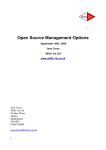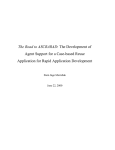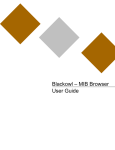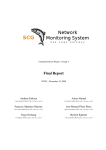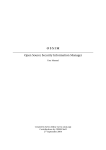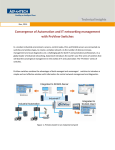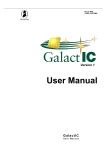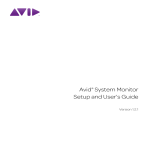Download Network Management Console
Transcript
Network Management Console Virat Gohil Bachelor’s Of Computer Applications, Maharaja Sayajirao University, Vadodara 15/05/2003 Summary This project is focussed on Network Management Systems, Java, and GNU/Linux, i.e how a network is managed by the use of the latest technology such as Java Management Extensions (JMX) and SNMP (Simple Network Management Protocol). The aim of the project was to review the products available in the market, that are frequently used my Network Administrators around the world. And then develop something similar to those to fit the requirement of DeepRoot Linux Pvt. Ltd.. The new system should give a strong base for further developments. Contents 1 Research on OpenNMS 1.1 About DeepRoot Linux Pvt. Ltd. . . . . . . . . . . . . . . . . . . . . . . . . 1.2 Description . . . . . . . . . . . . . . . . . . . . . . . . . . . . . . . . . . . . . 1.3 Downloading and Installing . . . . . . . . . . . . . . . . . . . . . . . . . . . 1.3.1 Dependencies . . . . . . . . . . . . . . . . . . . . . . . . . . . . . . . 1.4 Configuring . . . . . . . . . . . . . . . . . . . . . . . . . . . . . . . . . . . . . 1.4.1 discovery.xml . . . . . . . . . . . . . . . . . . . . . . . . . . . . . . . 1.4.2 poller-configuration.xml . . . . . . . . . . . . . . . . . . . . . . . . . 1.4.3 snmp-config.xml . . . . . . . . . . . . . . . . . . . . . . . . . . . . . 1.5 More on .xml files . . . . . . . . . . . . . . . . . . . . . . . . . . . . . . . . . 1.5.1 actiond-configuration.xml . . . . . . . . . . . . . . . . . . . . . . . . 1.5.2 AvailabilityReports.xsl SVGAvailReport.xsl PDFAvailReport.xsl . 1.5.3 viewsdisplay.xml . . . . . . . . . . . . . . . . . . . . . . . . . . . . . 1.5.4 views.xml . . . . . . . . . . . . . . . . . . . . . . . . . . . . . . . . . . 1.5.5 capsd-configuration.xml . . . . . . . . . . . . . . . . . . . . . . . . . 1.5.6 controller-configuration.xml . . . . . . . . . . . . . . . . . . . . . . 1.5.7 service-configuration.xml . . . . . . . . . . . . . . . . . . . . . . . . 1.5.8 create.sql database-schema.xml . . . . . . . . . . . . . . . . . . . . 1.5.9 datacollection-config.xml . . . . . . . . . . . . . . . . . . . . . . . . 1.5.10 notifications.xml . . . . . . . . . . . . . . . . . . . . . . . . . . . . . . 1.5.11 destinationPaths.xml . . . . . . . . . . . . . . . . . . . . . . . . . . . 1.5.12 notificationCommands.xml . . . . . . . . . . . . . . . . . . . . . . . 1.5.13 discovery-configuration.xml . . . . . . . . . . . . . . . . . . . . . . 1.5.14 eventconf.xml . . . . . . . . . . . . . . . . . . . . . . . . . . . . . . . 1.5.15 eventd-configuration.xml . . . . . . . . . . . . . . . . . . . . . . . . 1.5.16 users.xml / groups.xml . . . . . . . . . . . . . . . . . . . . . . . . . . 1.5.17 log4j.properties . . . . . . . . . . . . . . . . . . . . . . . . . . . . . . 1.5.18 magic-users.properties . . . . . . . . . . . . . . . . . . . . . . . . . 1.5.19 opennms-database.xml . . . . . . . . . . . . . . . . . . . . . . . . . 1.5.20 opennms-mapping.xml . . . . . . . . . . . . . . . . . . . . . . . . . . 1.5.21 opennms-jms.xml . . . . . . . . . . . . . . . . . . . . . . . . . . . . . 1.5.22 outage-configuration.xml . . . . . . . . . . . . . . . . . . . . . . . . 1.5.23 poller-configuration.xml . . . . . . . . . . . . . . . . . . . . . . . . . 1.5.24 rrdtool-graph.properties . . . . . . . . . . . . . . . . . . . . . . . . . 1.5.25 rtc-configuration.xml . . . . . . . . . . . . . . . . . . . . . . . . . . . 1.5.26 snmp-config.xml . . . . . . . . . . . . . . . . . . . . . . . . . . . . . 1.5.27 trapd-configuration.xml . . . . . . . . . . . . . . . . . . . . . . . . . 1.6 Starting & Stopping . . . . . . . . . . . . . . . . . . . . . . . . . . . . . . . . 2 5 5 5 7 7 11 11 11 11 12 12 12 13 13 13 13 13 13 13 14 14 14 14 15 15 15 15 15 15 15 15 16 16 16 16 16 16 17 1.6.1 Starting PostgreSQL . . . . . . . . . . . . . . . . . 1.6.2 Starting Tomcat . . . . . . . . . . . . . . . . . . . . 1.6.3 Starting OpenNMS . . . . . . . . . . . . . . . . . . 1.6.4 Stopping OpenNMS . . . . . . . . . . . . . . . . . . 1.6.5 Stopping Tomcat . . . . . . . . . . . . . . . . . . . 1.6.6 Stopping PostgreSQL . . . . . . . . . . . . . . . . 1.7 Exploring . . . . . . . . . . . . . . . . . . . . . . . . . . . . 1.7.1 The Home Page . . . . . . . . . . . . . . . . . . . . 1.7.2 Outage table . . . . . . . . . . . . . . . . . . . . . . 1.7.3 Availability . . . . . . . . . . . . . . . . . . . . . . . 1.7.4 Performance and Notification . . . . . . . . . . . . 1.7.5 Events . . . . . . . . . . . . . . . . . . . . . . . . . . 1.7.6 Viewing Events . . . . . . . . . . . . . . . . . . . . 1.7.7 Managing Events . . . . . . . . . . . . . . . . . . . 1.7.8 Outages . . . . . . . . . . . . . . . . . . . . . . . . . 1.7.9 Search . . . . . . . . . . . . . . . . . . . . . . . . . . 1.7.10 Searching for Nodes . . . . . . . . . . . . . . . . . 1.7.11 Searching Asset Information . . . . . . . . . . . . 1.7.12 Reporting . . . . . . . . . . . . . . . . . . . . . . . . 1.7.13 Performance Reports . . . . . . . . . . . . . . . . . 1.7.14 Custom Performance Reports . . . . . . . . . . . 1.7.15 Availability Reports . . . . . . . . . . . . . . . . . . 1.7.16 Notifications . . . . . . . . . . . . . . . . . . . . . . 1.7.17 Turning Notifications on . . . . . . . . . . . . . . . 1.7.18 Check and Acknowledge Notifications . . . . . . 1.7.19 Managing Notifications . . . . . . . . . . . . . . . . 1.7.20 Assets . . . . . . . . . . . . . . . . . . . . . . . . . . 1.7.21 Adding Asset information . . . . . . . . . . . . . . 1.7.22 Search Nodes based on Asset Information . . . 1.7.23 Exporting Asset Information . . . . . . . . . . . . 1.7.24 Importing Asset Information . . . . . . . . . . . . 1.8 Advanced Configuration . . . . . . . . . . . . . . . . . . . 1.8.1 Sending a notification on occurance of an event 1.8.2 Sending an SMS . . . . . . . . . . . . . . . . . . . . 1.8.3 Managing and Unmanaging Nodes and Services 1.8.4 Configuring Pollers . . . . . . . . . . . . . . . . . . 1.9 Troubleshooting . . . . . . . . . . . . . . . . . . . . . . . . 1.10 Tips . . . . . . . . . . . . . . . . . . . . . . . . . . . . . . . . . . . . . . . . . . . . . . . . . . . . . . . . . . . . . . . . . . . . . . . . . . . . . . . . . . . . . . . . . . . . . . . . . . . . . . . . . . . . . . . . . . . . . . . . . . . . . . . . . . . . . . . . . . . . . . . . . . . . . . . . . . . . . . . . . . . . . . . . . . . . . . . . . . . . . . . . . . . . . . . . . . . . . . . . . . . . . . . . . . . . . . . . . . . . . . . . . . . . . . . . . . . . . . . . . . . . . . . . . . . . . . . . . . . . . . . . . . . . . . . . . . . . . . . . . . . . . . . . . . . . . . . . . . . . . . . . . . . . . . . . . . . . . . . . . . . . . . . . . . . . . . . . . . . . . . . . . . . . . . . . . . . . . . . . . . . . . . . . . . . . . . . . . . . . . . . . . . . . . . . . . . . . . . . . . . . . . . . . . . . . 17 17 17 18 18 18 19 19 19 20 20 20 20 20 21 21 21 21 21 22 22 22 22 22 23 23 23 23 23 23 23 24 24 24 25 25 25 26 2 Development of a Management Console 27 2.1 User Requirements . . . . . . . . . . . . . . . . . . . . . . . . . . . . . . . . 27 2.2 Functional Specification . . . . . . . . . . . . . . . . . . . . . . . . . . . . . 27 3 2.3 2.4 2.5 2.6 2.7 System Implementation . . . . . . 2.3.1 Tools Used . . . . . . . . . . 2.3.2 Source Code Organization Completion Status . . . . . . . . . . Testing . . . . . . . . . . . . . . . . . 2.5.1 Conclusion . . . . . . . . . . User Manual . . . . . . . . . . . . . . 2.6.1 Installation . . . . . . . . . . 2.6.2 Maintenance . . . . . . . . . 2.6.3 Troubleshooting . . . . . . . 2.6.4 User Manual . . . . . . . . . 2.6.5 TODO . . . . . . . . . . . . . My Experiences . . . . . . . . . . . . . . . . . . . . . . . . . . . . . . . . . . . . . . . . . . . . . . . . . . . . . . . . . . . . . . . . . . . . . . . . . . . . . . . . . . . . . . . . . . . . . . . . . . . . . . . . . . . . . . . . . . . . . . . . . . . . . . . . . . . . . . . . . . . . . . . . . . . . . . . . . . . . . . . . . . . . . . . . . . . . . . . . . . . . . . . . . . . . . . . . . . . . . . . . . . . . . . . . . . . . . . . . . . . . . . . . . . . . . . . . . . . . . . . . . . . . . . . . . . . . . . . . . . . . . . . . . . . . . . . . . . . . . . . . . . . . . . . . . . . . . . . . . . . . . . . . . . . . . . 34 34 34 37 38 39 39 39 39 39 40 40 40 3 Bibliography 42 4 Acknoledgements 44 4 1 Research on OpenNMS 1.1 About DeepRoot Linux Pvt. Ltd. DeepRoot Linux is an upcoming GNU/Linux company, which was setup August 2000, housed in the northern outskirts of Bangalore, in Southern India. DeepRoot Linux was started with a simple objective: • to design products based on GNU/Linux and • to offer value-added and high-quality services on GNU/Linux. Its committment to the GNU/Linux community remains one of the strongest reasons for its work. It is aiming towards contributing on a larger scale - and if possible more than what it has taken from the community. It stresses upon two things. • Spreading GNU/Linux adoption across boundaries. • Making it easy for users to deploy GNU/Linux. Contact Information: Postal Address DeepRoot Linux Pvt. Ltd. #377, SFS-407, Opp. Mother Dairy, IVth Phase, Yelahanka New Town, Bangalore - 560064, INDIA. Phone Number: (Head Office and Development Center) +91 (80) 856 5624 Fax Number +91 (80) 856 2896 1.2 Description 5 A few years back, a group of people with a lot of network management experience were getting frustrated with the current state of network management software. They are expensive, difficult to configure, not reliable, and run on expensive hardware. They came up with OpenNMS, an open source platform. OpenNMS was designed from the ground up to be a one-for-one replacement for HP’s OpenView, IBM’s Tivoli, CA’s Unicenter, and the like. With that in mind, the OpenNMS team designed it as a network management tool, complete with SNMP hooks and a system-monitoring tool that can measure the availability of critical network services. It also has a configurable, event-driven messaging subsystem that allows us to plug-in event streams from other sources, such as vulnerability information from Nessus, tailed log files, and /proc-based monitors. And in good open source fashion (OpenNMS is released under the terms of the GPL), the product was designed to leverage preexisting tools where it made sense. Therefore, the SNMP performance data storage and graphing system uses RRDTool (Round Robin Database), the Web server/JSP container/servlet engine is Apache’s Jakarta Tomcat, and the underlying RDBMS is PostgreSQL. Built from the ground up in Java, the project has covered a lot of territory in a short period of time. Version 0.4 was the first public release at the end of 2000, with 1.0.2-2 currently available and 2.0 slated for end of 2003. But enough about releases and as there will be many more. 6 1.3 Downloading and Installing As the platform used was a Debian clone (Debian Woody 3.0, to be more presise), .deb packages are used as installation files, they are similar to .rpm under RedHat clones. The technique for installing is also a lot similar, download the .deb file and run dpkg -i [debfilename] and the software is ready to run. The other tool for downloading and installing is apt-get. apt-get is an installation tool which downloads the packages as well as any of its dependencies that are not installed in the current system. It then installs the dependencies first later the main package. This makes it a lot easier to install applications like OpenNMS where a software depend on a lot of other packages. The first method of searching and downloading the .deb packages one by one was chosen. Most of the packegs could be found with the debian distribution, but some like J2SDK, Tomcat 4.0 and ofcourse OpenNMS have to be downloaded. After downloading all the necessary dependencies start installing the packages one by one. As Sun’s new policy does not allow others to distribute Java VM or J2SDK, The .bin file from sun.java.com. was downloaded and then converted into .deb, so the OpenNMS can identify with it, and then install J2SDK 1.4. Finally the OpenNMS .deb package was installed. 1.3.1 Dependencies The following is Dependency tree for OpenNMS, upto three levels: • OpenNMS – librrd0 >= 1.0.10-1 ∗ libc6 >= 2.2.4-4 · libdb1-compat ∗ libgd-gif1 · libc6 (>= 2.2.5-13) · zlib1g (>= 1:1.1.4) ∗ libpng2 >=1.0.12 · libc6 (>= 2.2.5-13) · zlib1g (>= 1:1.1.4) – Perl ∗ perl-base = 5.6.1-7 7 · libc6 (>= 2.2.4-4) ∗ perl-modules >= 5.6.1-7 · perl (>= 5.6.1-1) ∗ libc6 >=2.2.4-4 · libdb1-compat ∗ libdb2 >=2:2.7.7-4 · libc6 (>= 2.2.5-13) ∗ libgdbm1 · libc6 (>= 2.2.4-4) – J2sdk1.4 or java2-runtime ∗ libc6 >= 2.3.1-1 · libdb1-compat ∗ xlibs >4.1.0 · xfree86-common (>4.2) · libc6 (>= 2.3.1-1) · libfreetype6 (>= 2.1.3-1) ∗ java-common – Mailx ∗ libc6 (>= 2.2.5-13) · libdb1-compat ∗ liblockfile1 (>= 1.0) ∗ mail-transport-agent (Exim was used as the mail transport agent) ∗ base-files (>= 2.2.0) · awk, base-passwd (>= 2.0.3.4) – Metamail ∗ libc6 (>= 2.2.4-4) · libdb1-compat ∗ libncurses5 (>= 5.2.20020112a-1) · libc6 (>= 2.2.4-4) – RRDTool ∗ libc6 (>= 2.2.4-4) · libdb1-compat ∗ libgd-gif1 ∗ libpng2 (>= 1.0.12) · libc6 (>= 2.2.5-13) 8 · zlib1g (>= 1:1.1.4) ∗ librrd0 (>= 1.0.10-1) · libc6 (>= 2.2.4-4) · libgd-gif1 · libpng2 (>= 1.0.12) – Tomcat4 ∗ java2-runtime — j2sdk1.3 — java-virtual-machine-dummy (J2SDK 1.4.003.0 was used) · libc6 >= 2.3.1-1 · xlibs >4.1.0 · java-common ∗ libtomcat4-java · java-common · libxerces2-java · libservlet2.3-java · libregexp-java ∗ logrotate · libc6 (>= 2.2.5-13) · libpopt0 (>= 1.6.4) · cron (>= 3.0pl1-53) or anacron · base-passwd (>= 2.0.3.4) ∗ adduser (>= 3.34) · perl-base (>= 5.6.0) · passwd (>= 961025) · debconf – PostgreSQL 7.1 or above ∗ libc6 (>= 2.2.4-4) · libdb1-compat ∗ libpam0g (>= 0.72-1) · libc6 (>= 2.2.5-13) · libpam-runtime ∗ libreadline4 (>= 4.2a-4) · libc6 (>= 2.2.4-4) · libncurses5 (>= 5.2.20020112a-1) ∗ libssl0.9.6 · libc6 (>= 2.2.4-4) 9 ∗ python2.1 · python (>= 2.1.3) · libc6 (>= 2.2.4-4) · libdb3 (>= 3.2.9-16) · libncurses5 (>= 5.2.20020112a-1) · libreadline4 (>= 4.3-1) · libssl0.9.6, zlib1g (>= 1:1.1.4) ∗ zlib1g (>= 1:1.1.4) · libc6 (>= 2.2.4-4) ∗ procps (>= 1:2.0) · libc6 (>= 2.2.4-4) · libncurses5 (>= 5.2.20020112a-1) ∗ debianutils (>= 1.13.1) · libc6 (>= 2.2.4-4) ∗ postgresql-client · libc6 (>= 2.2.4-4) · libpam0g (>= 0.72-1) · libreadline4 (>= 4.2a-4) · libssl0.9.6 · zlib1g (>= 1:1.1.4) · libpgsql2 (>= 7.2-3) ∗ adduser (>= 3.34) · perl-base (>= 5.6.0) · passwd (>= 961025) · debconf ∗ libpgsql2 (>= 7.2) · libc6 (>= 2.2.4-4) · libssl0.9.6 · libstdc++2.10-glibc2.2 (>= 1:2.95.4-0.010810) OpenNMS also depends on DBI and DBD-Pg perl modules that are used to communicate with postgreSQL. These can be found at www.cpan.org 10 1.4 Configuring The configuration files of OpenNMS are stored in /etc/opennms directory. The files are in .xml format so they are easy to understand and configure. The discovery.xml, snmp-config.xml and poller-configuration.xml files are more important as they have to be modified manually, the rest of the files are taken care of by the OpenNMS web console. 1.4.1 discovery.xml The range of IP addresses are defined in discovery.xml <include-range retries=”2” timeout=”3000”> <begin >192.168.0.1 </begin> <end >192.168.0.254</end> </include-range> The begin and the end tag define the start and the end of the range of IP Addresses that the opennms will scan. <specific >192.168.50.3 </specific > The above line is used when one wants to include a specific IP Address only e.g a printer or a webserver outside a particular range that is already defined. 1.4.2 poller-configuration.xml <include-range begin=”192.168.0.1” end=”192.1680.254”> Changes in the include-range tag are made to make sure that the pollers are aware of the range of IP Address. 1.4.3 snmp-config.xml The parameters used to connect with SNMP agents are defined in the snmp-config.xml file. Here is an example: <snmp-config retry=”3” timeout=”800” read-community=”public” write-community=”private”> <definition version=”v2c”> <specific>192.168.50.5</specific> </definition> <definition retry=”4” timeout=”2000”> <range begin=”192.168.50.1” end=”192.168.1.254”/> 11 <range begin=”192.168.60.1” end=”192.168.60.254”/> </definition> <definition read-community=bubba” write-community=”zeke”> <range begin=”192.168.70.1” end=”192.168.70.254”/> </definition> <definition port=”1161”> <specific>192.168.80.50</specific> </definition> </snmp-config> The attributes for the snmp-config tag are as follows: • retry: The number of attempts that will be made to connect to the SNMP agent. • timeout: The amount of time, in milliseconds, that OpenNMS will wait for a response from the agent. • read-community: The default ”read” community string for SNMP queries. • write-community: The default ”write” community string for SNMP queries. Note that this is for future development - OpenNMS does not perform SNMP ”sets” at the moment. All of the global parameters can be overridden with definition tags. These new SNMP definitions can apply to ranges or specific IP addresses. In addition, there are two other attributes available: • port: This overrides the default port of 161. • version: Here we can force either SNMP version 1 ”v1” or version 2c ”v2c”. 1.5 More on .xml files 1.5.1 actiond-configuration.xml Actions are external programs called based on events. This file controls the number of concurrent actions allowed as well as a time out for waiting on a return. 1.5.2 AvailabilityReports.xsl SVGAvailReport.xsl PDFAvailReport.xsl These 3 files contain information for converting availability reports to PDF format. 12 1.5.3 viewsdisplay.xml This file defines layout of categories for display in the web UI. The actual categories are defined in the views.xml file. 1.5.4 views.xml This file defines view categories, and services, to include per category as well as thresholds. These values are used by various components of OpenNMS such as RTC, the availability report generator and the web UI. 1.5.5 capsd-configuration.xml This file defines capabilities (services) to be checked for on nodes discovered either by the discovery daemon or via SNMP. It aslo specifies which addresses, and address ranges, that if discovered, should be managed or unmanaged. It also provides for a default state or ”management-policy” that covers addresses not specifically referenced. <capsd-configuration rescan-frequency=”86400000” management-policy=”unmanaged” > Finally we can set the ”rescan-frequency” which controls how often devices are rescaned or rechecked for which services they provide. This number, specified in milliseconds, is used to determine how often items should get rescanned. The default value is 86400000 or 24hrs. 1.5.6 controller-configuration.xml This file defines listeners for broadcast control JMS messages. 1.5.7 service-configuration.xml This file defines opennms services to start. This is VM specific and controls which services are started in which VMs. 1.5.8 create.sql database-schema.xml The file create.sql is the template for creating OpenNMS database. It is typically used by the install.pl script during the install process. The database-schema.xml defines the same database, in xml format, and is used by the filtering system to format database queries. 1.5.9 datacollection-config.xml This file contains data collection information for RRDTool. 13 1.5.10 notifications.xml This file defines which events or UEIs warrant notification and a destination path for said notification. <notification name=”nodeAdded”> <uei><![CDATA[http://uei.opennms.org/products/bluebird/nodes/nodeAdded]]></uei> <rule><![CDATA[IPADDR IPLIKE *.*.*.*]]></rule> <destinationPath>Email-Network/Systems </destinationPath> <text-message>OpenNMS has discovered a new node named <subject></notification> 1.5.11 destinationPaths.xml This file contains definitions for destination paths ie. whom to notify and by what method either pager, email or email-pager. 1.5.12 notificationCommands.xml This file defines how to accomplish various contact methods defined in destinationPaths.xml. This would include the location of executable and aliases for each type of contact along with any other information needed to send information of the specific type. <command type=”email”> <name>/bin/mail</name> <lookup>email</lookup> <lookup>mail</lookup> <comment>for sending email notifications</comment> <argument streamed=”false”> <substitution>-s</substitution> <switch>-subject</switch> </argument> <argument streamed=”false”> <switch>-email</switch> </argument> <argument streamed=”true”> <switch>-tm</switch> </argument> </command> 1.5.13 discovery-configuration.xml This file defines the ranges of addresses to discover, (ping sweep) as well as time outs, number of retries, and number of threads to dedicate to discovery. This file also provides 14 initial-sleep-time and restart-sleep-time. These values are in miliseconds and control how long after OpenNMS is started, that discovery should begin it’s initial pass through the addresses, and how long to wait between each additional pass. 1.5.14 eventconf.xml This file defines the Universal Event Identifiers or UEIs as well as their event masks, descriptions, log messages, and severity levels. 1.5.15 eventd-configuration.xml This file defines operating parameters for eventd such as time outs and number of listener threads. 1.5.16 users.xml / groups.xml These files hold information about users, and their contact information, as well as groups and membership. Information in these files is used for authentication on the web UI as well as for contact methods needed by notifications. 1.5.17 log4j.properties This file defines properties for log4j. It controls log size, rotation as well as logging levels for individual category. 1.5.18 magic-users.properties This file includes special users, and takes precedence over users.xml for the users that it has information about. This is used internally to control permissions for certain functions that interact with the web UI. 1.5.19 opennms-database.xml This file defines database type, name, authentication and mapping template to use for OpenNMS. 1.5.20 opennms-mapping.xml This file is empty but required by DTD for opennms-database.xml 1.5.21 opennms-jms.xml This file defines properties for OpenJMS. 15 1.5.22 outage-configuration.xml This file simply defines number of writer threads allowed by the outage manager. 1.5.23 poller-configuration.xml This file is used to define packages as well as set up the various pollers. A package includes several items such as address ranges, services, outage calendars, and down time models. 1.5.24 rrdtool-graph.properties This file is used to define RRD configurations for generating reports. 1.5.25 rtc-configuration.xml This file defines properties for RTC (Real Time Console) such as the rolling window used to calculate percentages of down time, web UI refresh interval and how often RTC sends updates to the web interface. 1.5.26 snmp-config.xml This file is used to define community strings for addresses or address ranges, one snmpconfig entry per community 1.5.27 trapd-configuration.xml This file defines the SNMP trap port. 16 1.6 Starting & Stopping Define JAVA HOME environment variable: #JAVA HOME=/usr/j2sdk1.4 The following sequence is to be followed while starting OpenNMS: 1. postgreSQL 2. Tomcat 3. OpenNMS The following sequence is to be followed while Stopping OpenNMS: 1. OpenNMS 2. Tomcat 3. postgreSQL 1.6.1 Starting PostgreSQL #/etc/init.d/postgresql start 1.6.2 Starting Tomcat #/etc/init.d/tomcat4 start OR #/usr/share/tomcat4/bin/startup.sh 1.6.3 Starting OpenNMS #/usr/share/opennms/bin/opennms.sh start OR #/sbin/service opennms start Now OpenNMS is up and running, give it some time to initialize all its services and pollers, then open a web browser and type the following URL for Debian clones: http://localhost:8180/opennms for others: 17 http://localhost:8080/opennms This is because the Apache Tomcat 4 server on Debian runs at port 8180. A dialog box pops up asking for Username and Password, ’admin’ is the username as well as the password. 1.6.4 Stopping OpenNMS #/usr/share/opennms/bin/opennms.sh stop OR #/sbin/service opennms stop 1.6.5 Stopping Tomcat #/etc/init.d/tomcat4 stop OR #/usr/share/tomcat4/bin/shutdown.sh 1.6.6 Stopping PostgreSQL #/etc/init.d/postgresql stop If some other service or application is using Tomcat4 or PostgreSQL then it is recommended that they should be kept running. 18 1.7 Exploring Now lets explore the OpenNMS Web console. 1.7.1 The Home Page From this centralized view, a quick overview of the current health of the network can be found. Notice in the upper right hand corner is information about the time and date on the management station, as well as the currently logged in user, and whether or not notices are currently turned on. 1.7.2 Outage table To the left of the screen is the outage table, labeled ”Nodes with Outages.” This is a list of nodes that currently have service outages. Clicking on a node in this list will present more specific information about the node, it’s services, and current, as well as historic, outages. From this page, information can be found regarding times that any outages occurred as well as when service was restored. 19 1.7.3 Availability In the center of the display are categories of services. For each category, there is listed the number of current outages as well as availability for the last 24 hours. The outage, and availability sections of this table are colored green, yellow, or red based on threshold values set by the administrator when the system was installed. 1.7.4 Performance and Notification On the right side of the display there are links to notifications and a portal to performance graphs. This section is used to create graphs from data collected via SNMP. 1.7.5 Events When an event occurs on the management station, it is stored in the database. These entries can be viewed on the events page which is accessed by clicking ”Events” on the menu bar near the top of the main page. 1.7.6 Viewing Events From this page, start by choosing the type of events to view. Options are ”outstanding events” (events that have not yet been acknowledged) and ”acknowledged events.” After selecting the type of events, an unfiltered list of events is presented in a table format. Each event has been assigned a severity and is colored appropriately. The legend can be viewed by pressing the button labeled ”Severity Legend”. More information about any event can be reached by clicking on the link in the ID column. 1.7.7 Managing Events From the main Events page there is a link to acknowledge or unacknowledge all events. In addition, filters can be applied to the event list by clicking on the ”+” or ”-” next to the item. Clicking the ”-” will exclude any item where the specific field that matches that value. Clicking the ”+” will exclude any item that does not match that value for the specific field. 20 1.7.8 Outages Access the outage page by clicking on the ”Outages” link in the main menu. On this page there is a table that contains information about all current outages for all managed devices. On this page, there is information regarding the type of outages, affected nodes and interfaces as well as the times of the outages. Clicking links in this table will provide additional information such as availability, events, and historical outages. 1.7.9 Search Clicking on the ”Search” link in the main menu takes us to the search page. From here we can search for nodes using various criteria. Once a search is initiated we recieve a list of nodes and their interfaces that match the search criteria. Each of these will be a link to the main node, or interface pages. These pages contain a very complete set of information about each device. Below is more detail on some of the different types of searches that can be done. 1.7.10 Searching for Nodes Generate lists of nodes that match any of a number of criteria including ip addresses, services, and machine names. Ranges of addresses can be entered for example, to provide a list of nodes that have ip addresses in that range. There are examples on this page, as well as some syntax rules to help refine searches. If all else fails there is also a link to ”list all nodes”. 1.7.11 Searching Asset Information If asset information has been entered for devices on the network, a search can can be created based on that information. Searches can be initiated based on category, information in any given field, or again there is a link to all nodes containing asset information. If no asset information has been entered for the devices, these searches will not return any matches. 1.7.12 Reporting Access the main reporting page by clicking ”reporting” in the main menu. From this point there are 3 options, performance reports, custom performance reports and availability reports. In this section we will look at each type of report, and how to generate and interpret the graphs and information provided. 21 1.7.13 Performance Reports Clicking on ”Performance Reports” will display a list of options for generating the standard performance reports. In the leftmost select box, choose an interface to generate a report on. Select any one SNMP capable interface. Next, choose what information to report on. Select any number of options in the second column. Select at least one option in each of the first 2 columns. Lastly, choose the timeframe to report on. After selecting the options, press the ”Submit” button to be taken to a bookmarkable page containing the resulting reports. 1.7.14 Custom Performance Reports After selecting ”Reports” from the main menu select ”Custom Performance Report”. At this point, we will be guided through a series of questions about the report we would like to create. First choose the interface on which we would like to report. Next we need to select between 1 and 4 data sources to report on. For each data source we can choose a title, color, line style and the type of value. Finally choose a title for our graph as well as a time period to report on. From this point, selecting next should display a bookmarkable graph. The complete address of this graph can be sent to another user via email, or instant message. 1.7.15 Availability Reports After selecting ”Reports” from the main menu select ”Availability Report”. From this point simply select the type of report we would like to create, and the category we would like to report on. Pressing the ”Get Report” button will open the requested report in a new browser window. 1.7.16 Notifications Notifications Notify us of events. 1.7.17 Turning Notifications on From the admin page, select Notification Status ON, then simply click ”Update Status”. This will turn notifications on/off for the entire system en masse. 22 1.7.18 Check and Acknowledge Notifications From the notifications page select the catagory that best describes the type of notifications in which we are interested. From here we will get a list of notifications that we can browse through and acknowledge, if needed. Unacknowledged notifications will continue to escalate as perscribed, until acknowledged. 1.7.19 Managing Notifications From the admin page and click ”Turn On/Off Notices by Service”. Follow instructions on this page to control notifications on a per service basis. 1.7.20 Assets Asset information helps us keep track of information about our managed devices. It can be used as search criteria, and is very handy in troubleshooting when we need a phone number for a vendor, or wish to document peculiar behavior for the next person that may access this information. 1.7.21 Adding Asset information Use the search page to find the node we would like to add asset information to, and click it. Then click ”Asset Info”. Fill out whatever fields we think we need. Click submit. When entering asset information, be very careful not to use any commas in any fields if we plan to export or import our data. THERE IS CURRENTLY NO WAY TO ESCAPE COMMAS IN THE CURRENT VERSION. 1.7.22 Search Nodes based on Asset Information Go to the search page or asset page and enter the criterium, and search. 1.7.23 Exporting Asset Information Exporting our asset information will give us a list of comma separated values. The first line of which will be the field names, and each subsequent line a device. 1.7.24 Importing Asset Information This feature, by itself, is basically useless in it’s current state. The node id must match for each device, and because of that, this information can not be passed from one management station to another, nor could it even be used across installations, unless we remapped the node ids. Information could be exported from a management station, imported into a spread sheet, then modified, exported back to a comma separated list, and then re-imported back into the same management station from which it was initially 23 exported. Or alternately the exported list could be modified by an external script and then re-imported if for instance we would need to duplicate information such as addresses for a large number of devices. Note that when re-importing information, the field names (the first line) should be left out. That is, if we export and save the resultant .csv file, pasting this file in the import field would cause an error in the first line. The field names are only there for the sake of another spreadsheet/database program that could read them as field names. 1.8 Advanced Configuration 1.8.1 Sending a notification on occurance of an event For this purpose the email address in the destination path of the user has to be defined from the admin- >configure notifications- >configure destination paths page. Then, the event notifications are configured through admin->configure notifications>configure event notifications page. Here the destination path for the events can be specified individually, so it makes it easy, to send particular events to different people or group of people according to ones needs. Remember to configure the MTA (Mail Transport Agent) first. 1.8.2 Sending an SMS The following things are required to send an SMS: • A GSM Instrument • A Data cable to connect the GSM instrument to the RS-232 port. • Alamin Gateway, a server and client for sending and recieving SMS. Then modify our notificationCommands.xml file to read: <command> <name>mobilePhoneSMS</name > <execute >/usr/bin/gsgc </execute > <comment>for sending GSM messages (SMS)</comment > <argument streamed=”false”> <substitution>–send</substitution> </argument> 24 <argument streamed=”false”> <switch>-np</switch> </argument> <argument streamed=”false”> <switch>-tm</switch> </argument> </command> 1.8.3 Managing and Unmanaging Nodes and Services It often happens that in a large network one requires to look for only a few services and nodes, and wants to ignore the rest, or ignore a few services and look after others, in such cases OpenNMS can be customized to monitor only those services and nodes that are required to be monitored. This can be done through the Admin->Manage and Unmanage Interfaces and services 1.8.4 Configuring Pollers Pollers can be configured to look for services that are important, one can even add ones own customised poller, these pollers look for services for the interfaces through their ports, they first try to telnet to that port and check if the port responds or not, if it does respond then the service is available on that interface. 1.9 Troubleshooting • While Installing opennms it says something like DBI or DBD::Pg not found? The solution to this problem is to install the DBI and DBD-Pg perl modules. These modules are available at www.cpan.org. • Installating the perl modules: Download the DBI-1.32.tar.gz and DBD-Pg-1.21.tar.gz, extract them into a directory, change into that directory, and run the following commands: #perl Makefile.PL #make #make test #make install 25 • mail process hangs, or goes into sleeping mode, and there are too many mail process in sleep mode. Downgrade from J2SDK 1.4.1 03 to 1.4.1 02 or 1.4.1 01, this bug in not in the mail transport agent but java mail APIs of J2SDK 1.4.1 03 1.10 Tips • If you used apt-get tool for installing opennms, then remember to take a backup of .deb packages in /var/cache/apt/archieves. • Also backup the Debianized form of the j2sdk bin file. • Save these files in case you need to reinstall opennms or port it to other machine. • The best way to learn OpenNMS is to subscribe the discuss list at http://www.opennms.org/users 26 2 Development of a Management Console The complicated configuration system and the System requirement of OpenNMS lead to the decision to develop a Management Console, that would fit the requirement of easily configurable and low on system resources on the server side. 2.1 User Requirements The following is a a list of Object IDs whose tables were Required: • Memory Table OID: .1.3.6.1.4.1.2021.4 • CPU Table OID: .1.3.6.1.4.1.2021.11 • Process Table OID: .1.3.6.1.4.1.2021.2.1 • Load Average OID: .1.3.6.1.4.1.2021.10.1 • Interface Table OID: .1.3.6.1.2.1.2.2.1 • LmSensors Table OID: .1.3.6.1.2.1.2021.14 The following individual Object IDs were Required to be displayed: • System Description OID: .1.3.6.1.2.1.1.1.0 • System Location OID: .1.3.6.1.2.1.1.6.0 • System Up Time OID: .1.3.6.1.2.1.1.3.0 • Contact Information OID: .1.3.6.1.2.1.1.4.0 • Hostname OID: .1.3.6.1.2.1.1.5.0 • System Services OID: .1.3.6.1.2.1.1.7.0 2.2 Functional Specification The application is build to display the current status of the Server, i.e a brief information of things like the free space on mounted partitions, load average, the interface information, etc. 27 The following is a Class Diagram showing CPUPanel.java & DiskGraph.java. 28 The following is a Class Diagram showing InfoPanel.java, GeeneralPanel.java & ProcessTable.java 29 The following is a Class Diagram showing DiskDeetails.java & Applet1.java 30 The following is a Class Diagram showing InterfacePanel.java, SensorPanel.java and LoadPanel.java 31 The following is a Class Diagram showing SystemCPUPanel.java, SystemDiskPanel.java ,SystemMemoryPanel.java 32 The following is a Class Diagram showing TimeUtil.java 33 2.3 System Implementation 2.3.1 Tools Used • Oracle’s JDeveloper was used as the Integrated Development Environment. • Westhawk University’s implementation of SnmpStack was used as the SNMP APIs for Java. • Chart2D, a Chart and Graph library from chart2d.sourceforge.net was used for displaying graphs. • Java Swing was used as main GUI. • Debian Woody 3.0 was used as the base Operating System. • net-snmp tools were used as command line interface to SNMP. • J2SDK 1.4.1 01 was used as the default Java Runtime Environment. • Latex was used for Documentation. 2.3.2 Source Code Organization All the classes are in the default package, The Applet1.class file initializes the GeneralPanel.class, InterfacePanel.java, SensorPanel.class & ProcessTablePanel.class. Java’s Naming conventions are followed everywhere, i.e Class name, Method name, etc. except the variable names, wherever possible the variable names are all in small letters. The following is the list of Source files that are either developed from scratch or extending third party libraries: • Applet1.java: This is the first file that is initiated as soon as the console is called. • GeneralPanel.java: This class is responsible for showing the following details: – Hostname OID: .1.3.6.1.2.1.1.5.0 – System Description OID: .1.3.6.1.2.1.1.1.0 – System Location OID: .1.3.6.2.1.1.6.0 – System Up Time OID: .1.3.6.1.2.1.1.3.0 – Contact Information OID: .1.3.6.1.2.1.1.4.0 – System Services OID: .1.3.6.1.2.1.1.7.0 • InterfacePanel.java: This class shows the information about any interfaces configured into the system. It shows the following information about each interface. – Index Table OID: .1.3.6.1.2.1.2.2.1.1 34 – Description Table OID: .1.3.6.1.2.1.2.2.1.2 – Type Table OID: .1.3.6.1.2.1.2.2.1.3 – Maximum Transfer Unit Table OID: .1.3.6.1.2.1.2.2.1.4 – Speed Table OID: .1.3.6.1.2.1.2.2.1.5 – Hardware Address TableOID: .1.3.6.1.2.1.2.2.1.6 – Admin Status Table OID: .1.3.6.1.2.1.2.2.1.7 – Oprational Status Table OID: .1.3.6.1.2.1.2.2.1.8 – InOctets Table OID: .1.3.6.1.2.1.2.2.1.10 – InPackets Table OID: .1.3.6.1.2.1.2.2.1.11 – InErrors TableOID: .1.3.6.1.2.1.2.2.1.14 – OutOctets Table OID: .1.3.6.1.2.1.2.2.1.16 – OutPackets Table OID: .1.3.6.1.2.1.2.2.1.17 – Out Discards Table OID: .1.3.6.1.2.1.2.2.1.19 – OutErrors Table OID: .1.3.6.1.2.1.2.2.1.20 – OutQueueLength OID: .1.3.6.1.2.1.2.2.1.21 • ProcessTablePanel.java: This class shows the information regarding the processes that are currently being monitored through snmpd.conf. It shows the following information about the process: – prIndex Table OID: .1.3.6.1.4.1.2021.2.1.1 – prName Table OID: .1.3.6.1.4.1.2021.2.1.2 – prMin Table OID: .1.3.6.1.4.1.2021.2.1.3 – prMax Table OID: .1.3.6.1.4.1.2021.2.1.4 – prCount Table OID: .1.3.6.1.4.1.2021.2.1.5 – errFlag Table OID: .1.3.6.1.4.1.2021.2.1.100 – errMsg OID: .1.3.6.1.4.1.2021.2.1.101 – prErrFixed OID: .1.3.6.1.4.1.2021.2.1.102 – prErrFixCmd OID: .1.3.6.1.4.1.2021.2.1.103 • SensorPanel.java: This class integrates the information about the disk, memory and cpu load. • SystemDiskPanel.java: This class fetches the following information ans passes it to DiskGraph.java – Path Table OID: .1.3.6.1.4.1.2021.9.1.2 35 – Total Table OID: 1.3.6.1.4.1.2021.9.1.6 – Used Table OID: 1.3.6.1.4.1.2021.9.1.8 – Device Table OID: 1.3.6.1.4.1.2021.9.1.3 – Should be free (KB) OID: 1.3.6.1.4.1.2021.9.1.4 – Should be free (%) OID: 1.3.6.1.4.1.2021.9.1.5 – Percentage Used OID: 1.3.6.1.4.1.2021.9.1.9 The Percentage Free is not fetched as it is calculated within the application to save Network Bandwidth. • DiskGraph.java: This class is invoked by the SystemDiskPanel class, it recieves three parameters through its constructor, The mount point, Total disk Space, Percentage Used, and index which is internally used on its mouse click event. The graph is a PieChart showing the mountpoint as its title, the percentage used and the percentage free. On click of this graph, SystemDiskPanel pops up a frame showing the details about the partition such as Total (GB), Free (GB), Used (GB), DevicePath, Should be free (GB), Should be Free (%), Used (%). • SystemMemoryPanel.java: This class shows the following information about the system’s memory: – Total Swap OID: 1.3.6.1.4.1.2021.4.3.0 – Available Swap OID: 1.3.6.1.4.1.2021.4.4.0 – Total Real OID: 1.3.6.1.4.1.2021.4.5.0 – Available Real OID: 1.3.6.1.4.1.2021.4.6.0 – Free Total (Swap + Real) OID: 1.3.6.1.4.1.2021.4.11.0 – Minimum Swap OID: 1.3.6.1.4.1.2021.4.12.0 – Shared Memory OID: 1.3.6.1.4.1.2021.4.13.0 – Buffered Memory OID: 1.3.6.1.4.1.2021.4.14.0 – Cached Memory OID: 1.3.6.1.4.1.2021.4.15.0 • CPUPanel.java: This is the only class which has another class nested inside it. This class is responsible to show the following details about the System Stats: – Index OID: 1.3.6.1.4.1.2021.11.1.0 – Swap In OID: 1.3.6.1.4.1.2021.11.2.0 – Swap Out OID: 1.3.6.1.4.1.2021.11.3.0 – IO Sent OID: 1.3.6.1.4.1.2021.11.4.0 – IO Recieved OID: 1.3.6.1.4.1.2021.11.5.0 36 – System Interrupts OID: 1.3.6.1.4.1.2021.11.6.0 – System Context OID: 1.3.6.1.4.1.2021.11.7.0 – CPU User OID: 1.3.6.1.4.1.2021.11.8.0 – CPU System OID: 1.3.6.1.4.1.2021.11.9.0 – CPU Idle OID: 1.3.6.1.4.1.2021.11.10.0 – CPU Raw User OID: 1.3.6.1.4.1.2021.11.11.0 – CPU Raw Nice OID: 1.3.6.1.4.1.2021.11.50.0 – CPU Raw System OID: 1.3.6.1.4.1.2021.11.51.0 – CPU Raw Idle OID: 1.3.6.1.4.1.2021.11.52.0 – Error Name OID: 1.3.6.1.4.1.2021.11.53.0 • get next.java: This class was modified from the original class so that it fits the requirement of returning the whole table instead of just one ID. • InfoPanel.java: GeneralPanel: and ProcessTable extend this class to share data members. • TimeUtil.java: This Class is used to translate the Time from timeticks to Human Readable form. • MyApplet.html: This file calles the main Applet, and passes the following three parameter to the Applet: – Hostname – Port – Community String 2.4 Completion Status Most of the project is finished, the only part remaining in this project is to integrate the LmSensors table which shows the CPU Temperature, CPU Fan speed, etc. This project is just the tip of iceburg, there lies a lot of potential in the project to be extended, this project has given a tough base to build a strong building upon it. A lot of research has gone behind making it as generic as possible, doing away with all the dependencies that could be done away, though at the cost of a bit efficiency, and ease of development and making it portable across platforms. 37 2.5 Testing The Console was extensively tested on different machines within the network as well as outside the network, these machines were many a times different in configuration, platform, etc. some had more partitions being monitored, or some had multiple interfaces. The console has been tested on the following Operating Systems: • Debian Woody 3.0 (net-snmp) • RedHat 8.0 (ucd-snmp) • RedHat 9.0 (ucd-snmp) • Knoppix 3.1 (net-snmp) The console has been tested on the following hardware platforms: • AMD Athelon 1800+ • AMD K6-II • P-III • Celeron Before selecting the external libraries to be used, each of the libraries were tested and reviewed individually. Some of the SNMP libraries that were tested are: • ActiveSNMP • DynamicSNMP • iReasoning • Java Dynamic Management Toolkit • Westhawk University’s implementation of SnmpStack • Koshna • Net-SnmpJ • openjmx • CmisJavaAPI • tmx4j (IBM) Some of the Charting and Graphing Libraries that were tested are: • JfreeChart • Chart2d • EasyCharts from object planet • Java chart construction kit (jcck) 38 2.5.1 Conclusion The console sometimes takes time to load on a slower client, but it does not impact the server’s performance. The network bandwidth could be optimized further. 2.6 User Manual 2.6.1 Installation Installation process of the console is pretty straight forward. • copy ’console’ directory to /var/www/html and change its permission to 777. (read,write,execute everyone) • copy .java.policy file to the home directory on the client side, only if the snmp port is below 1024. • edit MyApplet.html and change the following three parameters to suite the requirements. <PARAM NAME=”HOSTNAME” VALUE=”192.168.50.2” > <PARAM NAME=”PORT” VALUE=”161” > <PARAM NAME=”COMMUNITY” VALUE=”deeprw” > Now open any java enabled browser and type in the following URL: http://hostname/console/MyApplet.html The installation process assumes that the host machine has either net-snmp or ucdsnmp configured and running. 2.6.2 Maintenance The console is maintanence free, it does not save any data on to the file, or nither does it access any database. 2.6.3 Troubleshooting • If the applet does not show anything, make sure that .java.policy file in the users home directory grants access to port 161 to everybody. • If it still does not show anything, then check the parameters passed to the Applet in MyApplet.html. • Make sure that the browser is Java Enabled browser. • For further troubleshooting enable the java console from the web browser. • If the console shows in Process tab that there are no processes configured for monitoring, check the snmpd.conf 39 2.6.4 User Manual The console has only four tabbed panes that show all the information directly to the user, the only things that are hidden is the extensive partition information and the details on System Stats. Clicking the Pie Chart on the 4th tab shows the partition information, and clicking on the CPU Stats on the 4th tab shows the System Stats. 2.6.5 TODO • To incorporate LmSensors. • Get rid of parameters in the main html file, rather ask the user to enter the values at the runtime. • Optimize bandwidth usage, • Incorporate more graphs. 2.7 My Experiences I took this project as it had all the ingredients that I would have wished for in any project, i.e Java, GNU/Linux and Network. Initially the project seemed to be very challenging as I had never explored SNMP, but gradually with the help from my company I sailed through. I have learnt a lot during this project, for example I had never been able to use Debian, an operating system at its best. I also learnt SNMP, RRD upto an extent, and charting libraries for java. Even though I used only westhawk’s implementation of snmpstack I got to learn about other libraries such as iReasoning, DynamicSNMP, JDMK, etc. not only that, while documentation I learnt a whole new way of publishing, LATEX. The experience of going to Bangalore all by myself, a place where nobody was familier, was exagerating. This project has given me a lot of confidence on personal fronts. I met many, many people, most of them are now my friends, infact I now have a whole new family, a huge family. Working with people like Abhas, Nimit, Naren, Kiran, Rizvan, Sushmita, Narayan.. was a pleasure, they were really motivating people. While I also got the feel of working at a company, it almost felt as if I was at home. I could work nights if I wanted, I could take a day off to explore the city. 40 I also had a chance to view the AirShow 2003, and SunTech Days 2003. The first event was for fun, while the second one gave me an insight on upcomming technologies like J2ME and J2EE and tools such as Sun One Studio, JDeveloper etc. and meeting people like Scott McNelly, Rima Patel, Matt Thompson. I got to enjoy teaching socket programming to the students of Computer Engineering. While the last week of the project was full of action, I never felt tired of working on this project, as I just wanted to finish it up, unfortunately I could not finish the LmSensors part but I will try and finish it when I have some time for it. While trying to enable LmSensors I got a chance to learn the insights of recompiling the GNU/Linux Kernel, of different versions, which is a big feast in itself. 41 3 Bibliography • Essential SNMP by Douglas Mauro & Kevin Schmidt. • Java 2 Complete Reference by Patrick Naughton • OpenNMS Discussion Group http://www.opennms.org/users/discuss/ • Javadoc API’s • Javadoc generated from the snmpstack and chart2d libraries. • http://www.debian.org/ • http://www.objectplanet.com/easycharts • http://jcck.sourceforge.net/ • http://www.sourceforge.net/ • http://chart2d.sourceforge.net/ • http://www.tac.dk/ • http://www.visualmining.com/ • http://www.iReasoning.com/ • http://net-snmp.sourceforge.net/ • http://netsnmpj.sourceforge.net/ • http://www.adventnet.com/ • http://ei.cs.vt.edu/ • http://www.noao.edu/noaoprop/help/sample.html • http://www.opennms.org/users/discuss/ • http://www.net-snmp.org/ • http://www.monfox.com/ • http://java.sun.com/ • http://www.ibm.com/developerWorks/ • Developer IQ Magazine • Linux For You Magazine 42 • http://www.cpan.org/ • http://www.oracle.com/ • http://www.google.com/ • http://www.koshna.com/ • http://www.net-policy.com/ • http://www.zdnet.com/ 43 4 Acknoledgements Firstly I would like to thank my family, for encouraging me to go to Bangalore in order to persue this project. I would like to thank people from DeepRoot Linux Pvt. Ltd. Abhas Abhinav, Kiran A. N., Rizvan Khan, Nimit Gupta, Naren, Saurav, Sushmita, Prakash, Narayan. I would also like to thank, Nilesh Vaghela to inspire me to learn GNU/Linux, Manish Lakhani for helping me with my networking fundamentals, Ujval Trivedi for teaching me Java. All the faculty members from BCA, specially Mr. Rana Mukhopadhyay. Special thanks to Jai Thakkar, Amit, Kiran, Sudeep, Manoj, Anil, Pradeep, Satish, Raghu, Mr. S. Ananth Venkatesh and members of his family. 44













































